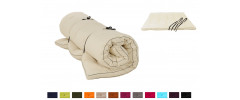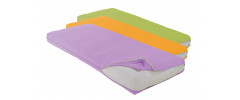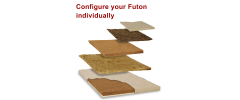Futon features and maintenance
You should know that
There is no optimal all-round mattress. Since people differ when it comes to their unique posture models, while choosing the appropriate sleeping base the individual body sensations shall be taken into account.
We offer mattresses and futons with different hardness degrees. These are not standardized but can significantly differ (in feeling) depending on the manufacturer, finally, the subjective sensation of the individual is decisive “measuring instrument”.
Coreless futons should be used mainly for solid ground - on the floor or on tatami.
Keep in mind that futon have the tendency to become more firm and more plain during the first weeks of the regular use and that in the new condition (especially those “coreless”) can loose up to 10% of their nominal dimensions. During the production the materials are a bit too big.
By the regular use (insertion time up to 3 months), the futon becomes flatter and therefore, longer and wider end and nominal dimensions can be usually achieved.. This “growing process” is taken into account during the production of futon.
Our futons are hand-made. In opposition to the mattresses, futons contain mostly materials that are not or partly point-elastic. The firmness and futon (final) height depends mainly on the body weight.
Here the rule is: the greater the body weight is, the higher the futon should be - in case of it also the body size should be taken into consideration. The higher the sleep base, the more likely it is to avoid deformations that occur when the filling can no longer resist the pressure of the body lying on it.
The futons have through-stitchings at regular distances. It is necessary, otherwise the materials inside the futon can slide on each other. The through-stitching has no decorative buttons as they can be felt during the usage of the futon as disturbing. If desired, we can also prepare futon with those buttons.
In case of slatted frames, you should keep in mind that the distances between the slats shall not be bigger than 4,5 cm. Otherwise, (depending on the force/body weight) the futon can be pressed between the slats and under these conditions can lose/change its original lying features, “hollows” can appear.
Maintenance tips
Maintenance of the natural mattresses/futons is mainly based on a good airing.
You should keep in mind that no moisture should nest inside
There is no breeding ground for the bacteria in a dry mattress. Coreless futons should be regularly rolled AND turned, however, futons with a core should be ONLY turned (The core -coconut, latex, horsehair - can be damaged in case of too frequent rolling).
It is recommended to do it always during the linen change, during the insertion phase in the first weeks, up to 2 times a week.
If the futon gets wet or moist - by e.g. Leaking liquid - the relevant place should be dried before the further usage of the futon can take place. Formation of certain smells is not excluded, as well as of mould stains.
General information on futon and natural mattress
Futons and mattresses differ especially at the beginning.
Whereas mattresses initially have a smooth and even surface, futons form (more or less depending on the materials) “lying hollows”.
After the insertion time however, it is no longer felt because the surface becomes even again due to the turning (or also rolling in case of coreless futons).
The futon becomes flatter and more firm as a result of forces influencing it. The forces influence the mattress significantly and therefore, it becomes firm. Mattresses are likely to become softer and in rare cases (depending on the body weight) after long-term use, they form lying hollows
In case of these processes body weight (the force influencing the futon/mattress), body size (distribution of the force on the surface) play the biggest role
as well as the base.



